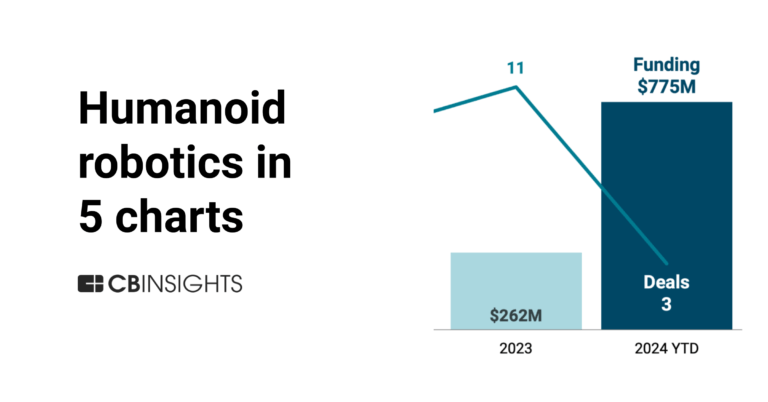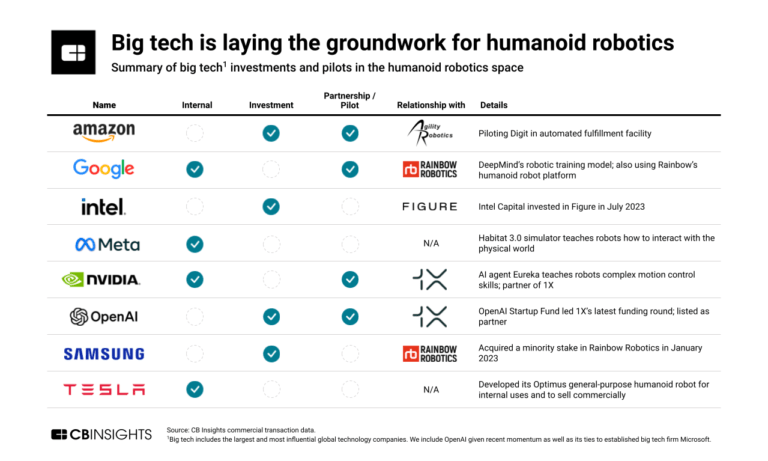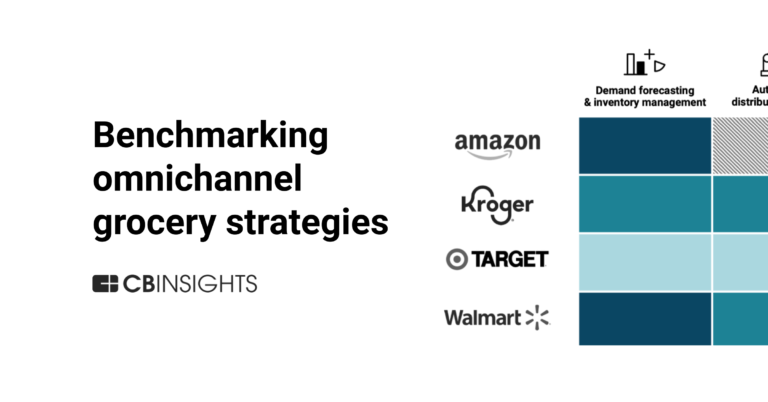
Agility Robotics
Founded Year
2015Stage
Corporate Minority | AliveTotal Raised
$179.6MMosaic Score The Mosaic Score is an algorithm that measures the overall financial health and market potential of private companies.
-5 points in the past 30 days
About Agility Robotics
Agility Robotics focuses on advanced automation solutions for the supply chain and manufacturing sectors. The company's main offerings include the humanoid robot Digit, designed to integrate into material handling workflows, and the cloud automation solution Agility Arc, which enhances various industrial processes. Agility Robotics primarily serves sectors such as third-party logistics, manufacturing, retail and eCommerce, and distribution. It was founded in 2015 and is based in Pittsburgh, Pennsylvania.
Loading...
ESPs containing Agility Robotics
The ESP matrix leverages data and analyst insight to identify and rank leading companies in a given technology landscape.
The industrial humanoid robot market specifically focuses on the development, manufacturing, and deployment of humanoid robots for use in industrial settings. Humanoid robots are designed to resemble the human body and are equipped with advanced sensors, actuators, and artificial intelligence capabilities. In industrial applications, humanoid robots are employed to perform tasks traditionally carr…
Agility Robotics named as Outperformer among 15 other companies, including Tesla, Boston Dynamics, and UBTECH Robotics.
Loading...
Research containing Agility Robotics
Get data-driven expert analysis from the CB Insights Intelligence Unit.
CB Insights Intelligence Analysts have mentioned Agility Robotics in 8 CB Insights research briefs, most recently on Feb 13, 2025.
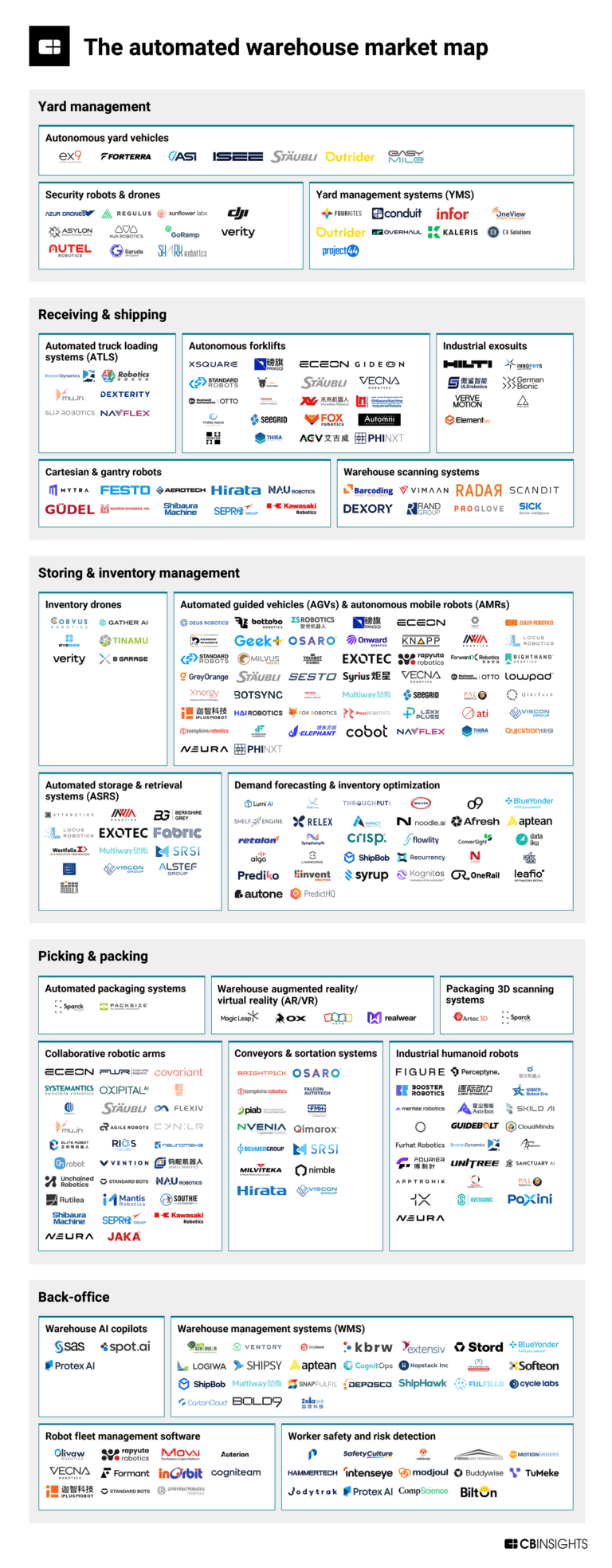
Feb 13, 2025
The automated warehouse market map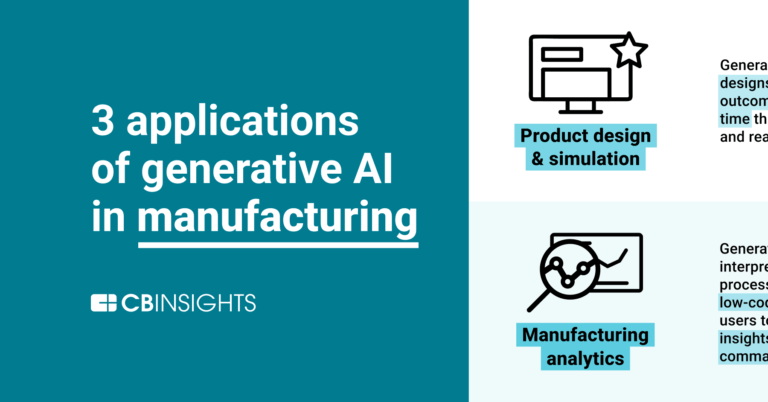
May 31, 2024
3 applications of generative AI in manufacturing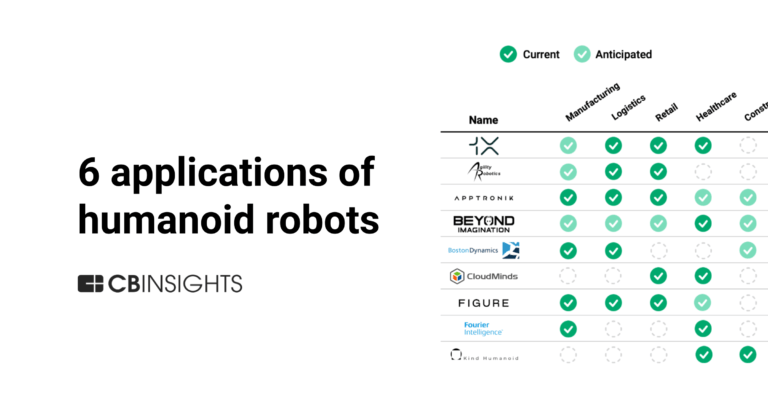
Mar 26, 2024
6 applications of humanoid robots across industries

May 17, 2022 report
AI 100: The most promising artificial intelligence startups of 2022Expert Collections containing Agility Robotics
Expert Collections are analyst-curated lists that highlight the companies you need to know in the most important technology spaces.
Agility Robotics is included in 9 Expert Collections, including Construction Tech.
Construction Tech
1,461 items
Companies in the construction tech space, including additive manufacturing, construction management software, reality capture, autonomous heavy equipment, prefabricated buildings, and more
Supply Chain & Logistics Tech
5,030 items
Companies offering technology-driven solutions that serve the supply chain & logistics space (e.g. shipping, inventory mgmt, last mile, trucking).
Robotics
2,020 items
This collection includes startups developing autonomous ground robots, unmanned aerial vehicles, robotic arms, and underwater drones, among other robotic systems. This collection also includes companies developing operating systems and vision modules for robots.
Advanced Manufacturing
6,534 items
Companies in the advanced manufacturing tech space, including companies focusing on technologies across R&D, mass production, or sustainability
AI 100
200 items
Job Site Tech
920 items
Companies in the job site tech space, including technologies to improve industries such as construction, mining, process engineering, forestry, and fieldwork
Agility Robotics Patents
Agility Robotics has filed 8 patents.
The 3 most popular patent topics include:
- actuators
- automotive transmission technologies
- gears

Application Date | Grant Date | Title | Related Topics | Status |
|---|---|---|---|---|
2/25/2020 | 10/29/2024 | Robotics, Actuators, Robots, Hexapod robots, Biomorphic robots | Grant |
Application Date | 2/25/2020 |
|---|---|
Grant Date | 10/29/2024 |
Title | |
Related Topics | Robotics, Actuators, Robots, Hexapod robots, Biomorphic robots |
Status | Grant |
Latest Agility Robotics News
Feb 21, 2025
Feature Credit: IM Imagery / Shutterstock AI-based humanoid robots could soon start becoming a workforce reality, thanks to parallel advances in generative AI and electromechanical components and mechatronics, enabling robots to have reasoning skills as well as physical abilities that exceed their predecessors. “We’re still very early in the journey, but it’s only going to get better,” says Dwight Klappich, a research vice president at Gartner. “AI is really the brain driving humanoid robots like Agility, Tesla Optimus, and Boston Dynamics’ Atlas. The intelligence is actually going to evolve faster than the mechatronics.” Mechatronics combines mechanics, electronics, and computers to create intelligent medical devices and robots, for instance. Boston Dynamics’ well known robotic dog ‘Spot’ was among the first advanced robots, and most use machine learning (ML) pattern recognition models. Today, key vendors — xAI, Meta, IBM, Boston Dynamics, Agility Robotics, Apptronik, Figure.ai, FourierIntelligence, and Sanctuary.ai — have plans to develop AI humanoid robots that can reason and adapt. Analysts expect such robots to be commercially available for manufacturers, supply chain and logistics giants, and retail industries within two years. Logistics giant GXO, for instance, has signed a multi-year agreement with Agility Robotics, and has deployed Agility’s Digit humanoid robot in a Spanx warehouse facility . It is also conducting pilot tests with Reflex Robotics and Apptronik humanoid robots. Figure.ai has signed two commercial contracts for its humanoid robots, according to the company. And xAI founder Elon Musk pledged that the company’s Optimus humanoid robots based on newly introduced Grok-3 foundation model — which was trained on xAI’s Colossus supercomputer — will be operational in months, not years. According to Gartner, by 2027 10% of all smart robots sold will be next-generation humanoid working robots. Hundreds of thousands of industrial robots have been in operation since the 1960s and many thousands of newer ‘smart robots’ that handle repetitive tasks are in production today. The AI robot proposition One projected use case for humanoid robots will be taking over hazardous human duties. But while there is significant investment and innovation going on, Gartner’s Klappich sees “still fairly limited use cases, mostly proof of concepts.” Within weeks, Rapid Robotics will unveil an industrial humanoid robot designed to “pick, pack, and palletize,” according to a company spokesman. The robot, called Rapid 3PRO, has been under development since September. Meanwhile, Meta plans to make investments in humanoid robots through its Reality Labs’ hardware division to first target the consumer market, according to a report from Bloomberg . At a recent UAE conference in Abu Dubai, Musk claimed xAI’s next Grok-3-fueled Optimus robot will leapfrog his rivals. “With Tesla building the most advanced humanoid robot, it can be directed by deep intelligence at the data set level,” Musk said, noting that Grok-3 was trained with synthetic data and far more Nvidia horsepower than any other model. “You can [then] produce any product, provide any service. There’s really no limit to the economy at that point.” There are more than a few naysayers who believe AI humanoid robots — in the factory or in the home — are still a ways off. “I do believe that humanoid robots or robots that have more human-like dexterity have potential within industrial operations. The idea of furthering human-robotic collaboration is easier if they both can operate the same set of tools. However, I don’t think that Musk’s claims of 2025 deployment are realistic,” says Carlos M. González, research manager of industrial IoT and intelligence strategies at IDC. “Many car manufacturers launched pilot programs in 2024, but we are still in the research phase, primarily since it was determined that the robots Musk showcased were being piloted by human operators and not acting independently,” he adds. Meanwhile, the cost of humanoid robots is high, and the ability for mechatronics makers to achieve human-like sensory capabilities and mobile flexibility remains challenging. One vendor source who asked not to be named said AI safety issues still need to be addressed. Outlook on deployments Despite the ongoing hurdles, CIOs and consultants see promise for AI humanoid robots in manufacturing, warehousing, retail, hospitality, healthcare, and construction. “Humanoid robots are advancing in dexterity, perception, and mobility at a rapid pace, but they are not yet at the reliability and cost-efficiency level of specialized automation like AMRs [autonomous mobile robots] or robotic arms,” says Chris Nardecchia, CIO of Rockwell Automation. “With Grok-3 and other generative AI models, these robots will improve in situational awareness and decision-making. Since these AI models are advancing rapidly, I would expect that this will translate into all robots advancing quicker than ever.” Nardecchia adds that widespread adoption will depend on several factors — cost, reliability, safety, regulatory compliance, and enterprise integration — noting that AI robotics will face the same barriers to adoption as other emerging technologies, but he does not dismiss the possibility. “Gartner’s prediction may be a bit optimistic and ambitious but not unattainable given the rapid advancements in AI, robotics, and edge computing,” Nardecchia says, adding that technical feasibility and economic viability will determine the technology’s viability. For its Spanx implementation, GXO has deployed Agility Solutions’ multi-purpose, human-centric Digit robots and Agility Arc, its cloud automation platform for Digit fleets, at a warehouse for the womenswear brand, integrating the fleet with existing automation such as AMRs. Currently, Digit robots assist with repetitive tasks, such as moving totes and placing them onto conveyors. Anders Brown, CEO of Tompkins Solutions, a systems integrator that has a partnership with Agility, says Agility, which has the manufacturing capacity to produce up to 10,000 robots a year, has deployed multiple Digit robots at various customer locations for production use as part of proof of concept or robot-as-a-service (RaaS) arrangements. “The key to truly scaling beyond initial deployments is having a collaboratively safe robot, which Agility has made a pledge to release in 2026,” Brown says. Tom Richer, CEO of AI consultancy Intelagen and a former CIO, pointed to Figure.AI robot, which has garnered significant attention and secured funding and a partnership with BMW for manufacturing applications. Along with xAI’s Optimus, Richer also noted AgiBot, a Chinese company that claims to have produced almost 1,000 units, and Boston Dynamics, whose humanoid robot Atlas has demonstrated impressive feats of movement and task execution, “but widespread deployment remains limited.” “AI humanoid robots are still largely in early stages of development but making progress,” Richer says. “These examples, while not yet ubiquitous, demonstrate the accelerating progress in AI humanoid robotics, driven by advancements in machine learning and computer vision, and suggest that the 2027 [Gartner] prediction may well be within reach.” Boston Dynamics will soon start testing its Atlas humanoid robot in Hyundai facilities this year, according to a company spokesman, who added that Boston Dynamics believes Atlas will have opportunities to move parts with complex sizes, shapes, and weights in other industries as well. “Humanoids will be most effective if they are deployed with in-depth models of a facility and lots and lots of data about how it operates, and the increased focus on AI only helps advance the research and development of humanoid robots,” the spokesman said. “Many companies are jumping into the humanoid race, but not all of them will be successful and we’re excited for the competition, it means the industry is advancing and innovating.” In terms of that increased focus on AI, Figure.AI this week announced Helix , what the company describes as “a generalist vision-language-action (VLA) model that unifies perception, language understanding, and learned control to overcome multiple longstanding challenges in robotics.” Rockwell CIO Nardecchia says large-scale deployments will likely take longer than 2027, but pilot programs and niche use cases will increase within that timeframe. “I would anticipate some industries, which are particularly impacted by labor shortages, partnering with robotic technology companies and making investments, or even using their own manufacturing capabilities to jump the line to leverage these technologies sooner than their competitors,” the CIO says. The batch of AI humanoids coming within the next few years — if technically achieved — will be a significant advance for all of human society, Gartner’s Klappich notes. “Humanoid robots imitate the human body with a head with sensors and cameras for sensing its environment; a body that houses the power and mechanicals; arms and hands/grippers for grasping, manipulating, and carrying items; and legs for dynamic locomotion all powered by an AI-enabled brain,” Klappich wrote in a Gartner supply chain trends report published last March. “While there are many examples of highly productive mobile robots that use wheels, there have been few successful examples of robots that offered mobile manipulation, such as moving around and picking up and carrying things, and that could handle varied or unpredictable tasks and terrain,” Klappich wrote. “The next generation of humanoid working robots will combine sensory awareness with mobile manipulation and dynamic locomotion to perform productive work that was previously relegated to biological human.” Related content
Agility Robotics Frequently Asked Questions (FAQ)
When was Agility Robotics founded?
Agility Robotics was founded in 2015.
Where is Agility Robotics's headquarters?
Agility Robotics's headquarters is located at 91 43rd Street, Pittsburgh.
What is Agility Robotics's latest funding round?
Agility Robotics's latest funding round is Corporate Minority.
How much did Agility Robotics raise?
Agility Robotics raised a total of $179.6M.
Who are the investors of Agility Robotics?
Investors of Agility Robotics include Schaeffler Group, Playground Global, Sony Innovation Fund, Safar Partners, DCVC and 9 more.
Who are Agility Robotics's competitors?
Competitors of Agility Robotics include Apptronik, Foundation, Sanctuary AI, Mentee Robotics, Figure and 7 more.
Loading...
Compare Agility Robotics to Competitors

Figure engages in the development of general-purpose humanoid robots. Its main product is a commercially viable autonomous humanoid robot designed to perform a variety of tasks across multiple industries, combining human-like dexterity with advanced artificial intelligence. Its humanoid robots are engineered to support sectors such as manufacturing, logistics, warehousing, and retail. It was founded in 2022 and is based in Sunnyvale, California.

Boston Dynamics specializes in advanced mobile manipulation robots within the robotics and automation industry. The company offers robots with capabilities in dynamic sensing, industrial inspection, and mobile manipulation, as well as software for fleet management and analysis. Boston Dynamics primarily serves sectors such as manufacturing, energy, construction, logistics, and government with their robotic solutions. It was founded in 1992 and is based in Waltham, Massachusetts. Boston Dynamics operates as a subsidiary of Hyundai Motor Company.
Perceptyne Robots focuses on the integration of artificial intelligence with robotics within the deeptech and automation sectors. The company provides industrial humanoid robots intended to automate dexterous tasks in various industries, incorporating features like vision guidance, tactile sensing, and teleoperation training. Perceptyne Robots serves sectors that require automation solutions, including manufacturing. It was founded in 2021 and is based in Hyderabad, India.

Mentee Robotics specializes in the development of humanoid robots with advanced artificial intelligence capabilities within the robotics and AI technology sectors. Their robots are equipped with full-body motion planning and control, capable of performing complex tasks through dynamic interaction with their environment. The company's products are designed to serve sectors that require automation through sophisticated robotics, such as manufacturing, logistics, and healthcare. It was founded in 2022 and is based in Herzliya, Israel.

Sanctuary AI specializes in the development of humanoid general-purpose robots within the robotics industry. The company offers robots that are capable of performing a variety of tasks autonomously or under remote human supervision, aiming to improve safety, efficiency, and sustainability in the workplace. Sanctuary AI's robots are designed to work alongside humans, addressing labor shortages and providing opportunities for remote operation of physical tasks. It was founded in 2018 and is based in Vancouver, Canada.

Apptronik specializes in the development of humanoid robots for various automation tasks across multiple industries. Its main product, Apollo, is a general-purpose humanoid robot designed to perform a wide range of tasks that typically require human effort, such as case picking, palletization, and machine tending. Apptronik's robots are intended to address labor shortages, reduce workplace injuries, and improve operational efficiency in sectors like third-party logistics (3PL), retail, and manufacturing. It was founded in 2015 and is based in Austin, Texas.
Loading...
